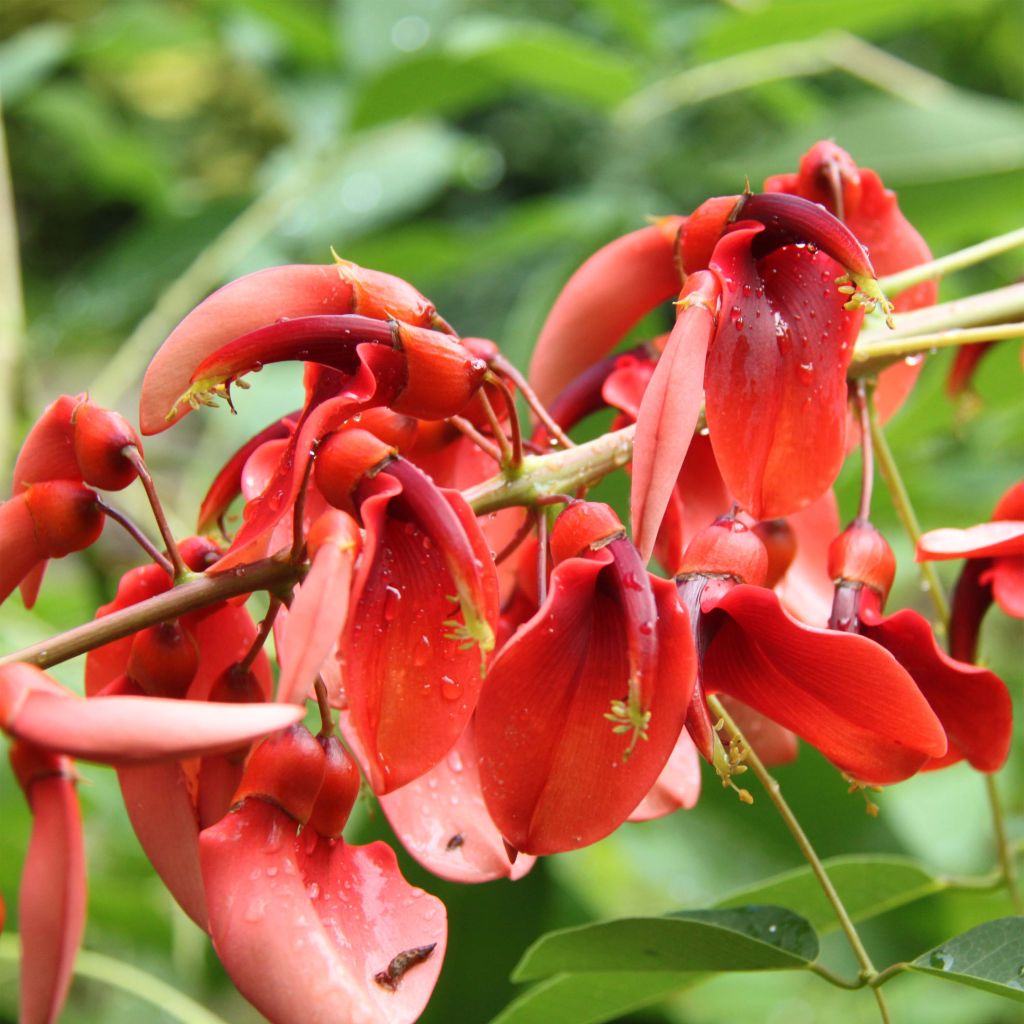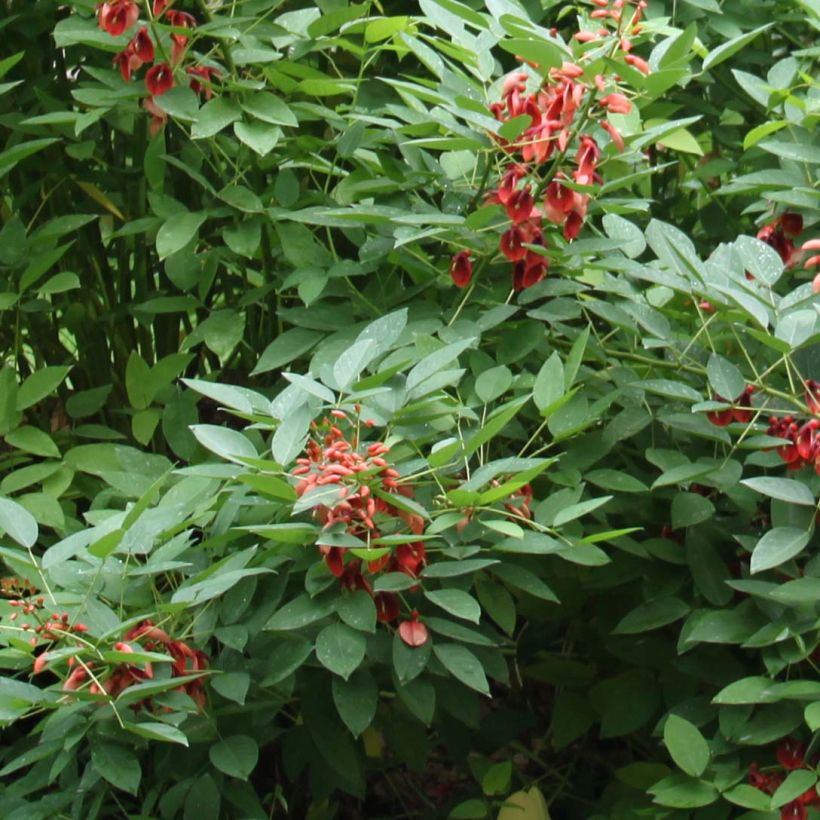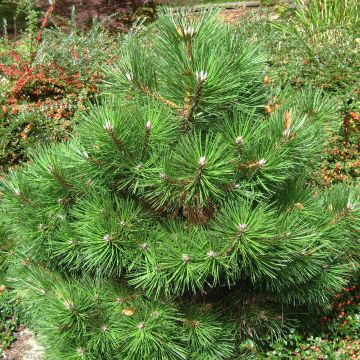

Erythrina crista-gallii Compacta - Erythrina crista-gallii Compacta


Erythrina crista-gallii Compacta - Erythrina crista-gallii Compacta


Erythrina crista-gallii Compacta - Erythrina crista-gallii Compacta
Erythrina crista-galli Compacta - Cockspur Coral Tree
Erythrina crista-galli Compacta
Cockspur Coral Tree, Cry Baby Tree
Why not try an alternative variety in stock?
View all →This plant carries a 24 months recovery warranty
More information
We guarantee the quality of our plants for a full growing cycle, and will replace at our expense any plant that fails to recover under normal climatic and planting conditions.
From €5.90 for pickup delivery and €6.90 for home delivery
Express home delivery from €8.90.
Does this plant fit my garden?
Set up your Plantfit profile →
Description
Erythrina crista-galli 'Compacta' possesses the same qualities as the Cockspur Coral Tree, but this smaller selection is better suited for container gardening or small gardens and may be even more floriferous. This smaller coral tree shows the same ease of cultivation and equally spectacular late spring flowering, with clusters of vibrant red flowers, highlighted by acacia-like foliage, in a brilliant greenish-blue shade. With a slightly gnarled habit, this shrub with thorny branches deserves to be planted more in our gardens: particularly ornamental and exotic, relatively hardy at its base, it can be grown in the ground as a perennial in mild climates. Gardeners in continental climates will cultivate it as a conservatory plant.
Erythrina crista-galli is a small tree or shrub of the Fabaceae family, native to South America, especially Bolivia, Argentina, Brazil, Paraguay, and Uruguay. This species, the hardiest of the genus, populates forests along rivers, marshes, and swamps. In its natural environment, the cockspur coral tree forms a tree 4 to 9 m (13 ft 1 in to 29 ft 6 in) tall, with a thick, gnarled trunk, and a cross-hatched fissured bark. Its branches form a spreading crown, with deciduous foliage during the dry season. It is cultivated in temperate climates as a herbaceous plant in the ground, or as a shrub in a greenhouse. Its initially upright habit spreads over the years if it manages to form a small tree.
The shrubby 'Compacta' form, obtained in the Netherlands, does not exceed 1.50 m (4 ft 11 in) in all directions at the age of 10, and does not form trunks, but numerous stems, sometimes fifty, that emerge from the base in spring, somewhat like a tree clover. At maturity, it will reach about 3 m (9 ft 10 in) in height and 2 m (6 ft 7 in) in width, under good conditions. These long, slender, and thorny shoots bear leaves that are deciduous in our latitudes, meaning they fall in autumn. Each leaf is divided into 3 large, shiny, bluish-green leaflets. The flowering takes place in late spring in mild climates, mid-August if the plant has regrown its branches in spring. At the tips, as well as along the year's branches, clusters exceeding 25 cm (9.8 in) in length form. The coral-red pea flowers have a large standard directed downwards. This nectar-rich flowering attracts many pollinating insects. As in most Fabaceae, this plant has a powerful taproot capable of fixing atmospheric nitrogen, which is an adaptation to poor soils.
A spectacular shrub, with a somewhat prehistoric appearance, the Compacta cockspur coral tree is sometimes difficult to integrate into the garden. In the ground, one could combine the relentless red of its flower clusters with the white flowers of a buddleia, gauras, or Romneya coulteri. It could also be planted next to the Texas mountain laurel, a curious shrub of the Fabaceae family producing blue clusters, or a night-blooming jasmine (Cestrum nocturnum), for its fragrance. This shrub is undemanding of soil type and not difficult to grow in a large pot to overwinter in cold regions.
Report an error about the product description
Erythrina crista-galli Compacta - Cockspur Coral Tree in pictures




Plant habit
Flowering
Foliage
Botanical data
Erythrina
crista-galli
Compacta
Fabaceae (Papilionacea)
Cockspur Coral Tree, Cry Baby Tree
South America
Other Erythrina
Planting and care
Erythrina crista-galli Compacta should be planted in spring, after the frost, in open ground in regions with mild winters. Choose a sunny location sheltered from cold winds. Plant it in well-drained soil, enriched with sand and compost, as it dislikes waterlogged soils that cause its roots to rot. Its hardiness is around -10°C (14 °F) when the crown is covered with a thick layer of mulch 30cm (11.8 in) deep and the plant has been grown in open ground for 2 or 3 years. This plant appreciates soils that remain moist during its flowering. If the soil becomes drier after flowering, it will not harm the plant (this is what happens in its country of origin). In November, except in regions where there is no frost, prune the stems to 10cm (3.9 in) above the ground before spreading the mulch. Regularly remove faded flowers to prolong flowering. Beware of attacks by slugs and snails in spring on young plants.
Cultivation in pots: choose a large container with drainage holes. Place a layer of gravel or clay balls at the bottom of the pot. Use a mixture containing 1/3 garden soil, 1/3 compost, and 1/3 coarse sand. Monitor watering in summer. Only apply fertilizer if the plant blooms poorly. Regularly remove faded flowers to prolong flowering. Move the plant to a bright and lightly heated veranda or a cold greenhouse from October onwards.
Planting period
Intended location
Care
-
, onOrder confirmed
Reply from on Promesse de fleurs
Evergreen shrubs
Haven't found what you were looking for?
Hardiness is the lowest winter temperature a plant can endure without suffering serious damage or even dying. However, hardiness is affected by location (a sheltered area, such as a patio), protection (winter cover) and soil type (hardiness is improved by well-drained soil).

Photo Sharing Terms & Conditions
In order to encourage gardeners to interact and share their experiences, Promesse de fleurs offers various media enabling content to be uploaded onto its Site - in particular via the ‘Photo sharing’ module.
The User agrees to refrain from:
- Posting any content that is illegal, prejudicial, insulting, racist, inciteful to hatred, revisionist, contrary to public decency, that infringes on privacy or on the privacy rights of third parties, in particular the publicity rights of persons and goods, intellectual property rights, or the right to privacy.
- Submitting content on behalf of a third party;
- Impersonate the identity of a third party and/or publish any personal information about a third party;
In general, the User undertakes to refrain from any unethical behaviour.
All Content (in particular text, comments, files, images, photos, videos, creative works, etc.), which may be subject to property or intellectual property rights, image or other private rights, shall remain the property of the User, subject to the limited rights granted by the terms of the licence granted by Promesse de fleurs as stated below. Users are at liberty to publish or not to publish such Content on the Site, notably via the ‘Photo Sharing’ facility, and accept that this Content shall be made public and freely accessible, notably on the Internet.
Users further acknowledge, undertake to have ,and guarantee that they hold all necessary rights and permissions to publish such material on the Site, in particular with regard to the legislation in force pertaining to any privacy, property, intellectual property, image, or contractual rights, or rights of any other nature. By publishing such Content on the Site, Users acknowledge accepting full liability as publishers of the Content within the meaning of the law, and grant Promesse de fleurs, free of charge, an inclusive, worldwide licence for the said Content for the entire duration of its publication, including all reproduction, representation, up/downloading, displaying, performing, transmission, and storage rights.
Users also grant permission for their name to be linked to the Content and accept that this link may not always be made available.
By engaging in posting material, Users consent to their Content becoming automatically accessible on the Internet, in particular on other sites and/or blogs and/or web pages of the Promesse de fleurs site, including in particular social pages and the Promesse de fleurs catalogue.
Users may secure the removal of entrusted content free of charge by issuing a simple request via our contact form.
The flowering period indicated on our website applies to countries and regions located in USDA zone 8 (France, the United Kingdom, Ireland, the Netherlands, etc.)
It will vary according to where you live:
- In zones 9 to 10 (Italy, Spain, Greece, etc.), flowering will occur about 2 to 4 weeks earlier.
- In zones 6 to 7 (Germany, Poland, Slovenia, and lower mountainous regions), flowering will be delayed by 2 to 3 weeks.
- In zone 5 (Central Europe, Scandinavia), blooming will be delayed by 3 to 5 weeks.
In temperate climates, pruning of spring-flowering shrubs (forsythia, spireas, etc.) should be done just after flowering.
Pruning of summer-flowering shrubs (Indian Lilac, Perovskia, etc.) can be done in winter or spring.
In cold regions as well as with frost-sensitive plants, avoid pruning too early when severe frosts may still occur.
The planting period indicated on our website applies to countries and regions located in USDA zone 8 (France, United Kingdom, Ireland, Netherlands).
It will vary according to where you live:
- In Mediterranean zones (Marseille, Madrid, Milan, etc.), autumn and winter are the best planting periods.
- In continental zones (Strasbourg, Munich, Vienna, etc.), delay planting by 2 to 3 weeks in spring and bring it forward by 2 to 4 weeks in autumn.
- In mountainous regions (the Alps, Pyrenees, Carpathians, etc.), it is best to plant in late spring (May-June) or late summer (August-September).
The harvesting period indicated on our website applies to countries and regions in USDA zone 8 (France, England, Ireland, the Netherlands).
In colder areas (Scandinavia, Poland, Austria...) fruit and vegetable harvests are likely to be delayed by 3-4 weeks.
In warmer areas (Italy, Spain, Greece, etc.), harvesting will probably take place earlier, depending on weather conditions.
The sowing periods indicated on our website apply to countries and regions within USDA Zone 8 (France, UK, Ireland, Netherlands).
In colder areas (Scandinavia, Poland, Austria...), delay any outdoor sowing by 3-4 weeks, or sow under glass.
In warmer climes (Italy, Spain, Greece, etc.), bring outdoor sowing forward by a few weeks.

















































